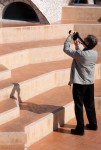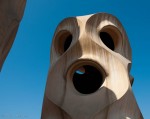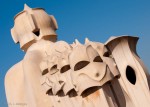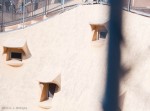So, imagine you’re a wealthy industrialist — or something — in the late 19th/early 20th century in Barcelona. You want an apartment in the city, and you’ve got this friend who’s an architect who’s designed a truly rather one-of-a-kind Cathedral. And now he’s got a great idea – he’ll build you an apartment building, and you can live on the first floor, and rent out the rest. Here’s the catch: you’ve got to let him design everything his way. And I do mean everything.
That’s pretty much the pitch that Gaudí must have put to his friends, the wealthy guys in Barcelona who supported him during his career. There are several of these Gaudí buildings that are now museums open to the public. One of them is noted for the dragon-scale-like roof tiles on the top – there’s a photo of that included in the set below.
However, we didn’t go into that one. The one we went into, Casa Milà, was the one with all the funky stuff on top. I don’t know how else to describe it.
Last week an American architect friend here in Tübingen gave a talk in which she described architects like Frank Lloyd Wright as “starchitects”: i.e., if you hire someone like Frank Lloyd Wright, you want them to design you a house because of who they are, not because they are going to work with you to design a house of your dreams. Rather, the house they design will be the one of their dreams … whether you like it or not may be immaterial. In tomorrow’s post, we’ll take a peek inside the Casa Milà, and see what it meant when Gaudí designed not only your building, but your apartment, furniture, door handles, etc. I’d say Gaudí was definitely a “starchitect,” possibly long before anyone coined the term. 😉
However, today we’re focusing only on the outside of the building. Comparing the design to its surroundings, you’ll see that in the neighborhood there were other interesting buildings, but not as different from each other as the Casa Milà is from the buildings nearby. I’ve included photos taken of the building from the street level (including one from the bus), as well as some photos of and from the rooftop area of Casa Milà. The building has been completely redone inside as a museum; originally, each floor other than the ground floor had one or more private apartments. The family that owned the building would always live on the first floor (which in the North America would be called the 2nd floor). Crucially, they didn’t live on the top floor. Chris speculated that perhaps it was cooler (literally) not to live on an upper floor, even though the views from the top would be better. But Barcelona can get quite hot in the summer, and the higher you go, the hotter you’d be, in the days before air-conditioning.
Anyway, as I said, today’s photos are all of the outside of the building. And I did take enough photos to warrant 2 posts about the building, so I guess in some ways I found it interesting. However, I have to say, that most of my photos are more documentary than anything else. The final few photos in today’s set were taken when I got tired of trying to figure out an interesting angle to take of Gaudí’s sculptures/chimneys/ventilation towers. I didn’t like them, and so instead I started to look for other interesting artistic angles to photograph, like the accidental shadows from the mesh fences that now detract from the roof design, but I’m sure were added to keep tourists from falling off the building, or through the atrium to the lobby.
I guess one of the reasons I’m not a huge Gaudí fan is that is really seems like it’s really a huge money-making operation these days, as much as anything else. For$25 per person, you have the privilege of entering one of these buildings (and taking photos if you want to). Pay an even higher fee, and then they’ll tell you something about what you’re seeing. That’s pretty steep, if you ask me. There’s a small brochure that comes with the basic admission fee that provides a very bare bones description about the building as a whole. You need to pay a higher fee to get an audio tour, or an even higher fee to get a guided tour. Without those tours, there’s little signage around to tell you what you’re looking at. I found that really odd.
But never fear. They do provide ready opportunities to buy chachkas and guidebooks about the place: once you’re inside, you have to walk through two separate gift shops in order to exit the building.
You can go into several different Gaudi buildings like this around Barcelona, but we only checked out Casa Milà. See what you think … and come back tomorrow when we see how the other half-lived inside one of Gaudí’s luxury apartments.
- House with the “dragon-scale” roof is in the middle
- Casa Milà seen from the bus
- Casa Milà Façade
- Casa Milà and its neighbors
- Casa Milà Façade with building next door
- Casa Milà Façade – detail
- Casa Milà balcony detail
- Casa Milà interior balconies
- Casa Milà front staircase
- Casa Milà rooftop photo #1
- Casa Milà rooftop photo #2
- Non-Gaudí house across the street
- View of other rooftops
- Looking down the street from the roof
- Looking down the street from the roof – photo #2
- Casa Milà rooftop photo #3
- Friendly Tourist looking for an interesting shot
- Rooftop sculpture/chimney
- Rooftop sculpture/chimney/ventilation tower
- Rooftop Ventilation sculptures/towers
- Rooftop Ventilation sculptures/towers/chimney
- Artsy shadows on chimney
- Shadows on a window
- A face on the wall
- Beyond the fence
- Through the fence, Casa Mirà



























your photos are beautiful. the building is odd it looks like a mud wasp house. I love the sculptures on the roof which also have a practical purpose.
do you think that that is where the word Gaudy comes from. I doubt it but it kind of makes me think . . .
Barcelona has a lot of interesting Architecture
These are beautiful — I can’t wait for the next installment to see not only how the design is carried through to the inside, but the shots you decided on.